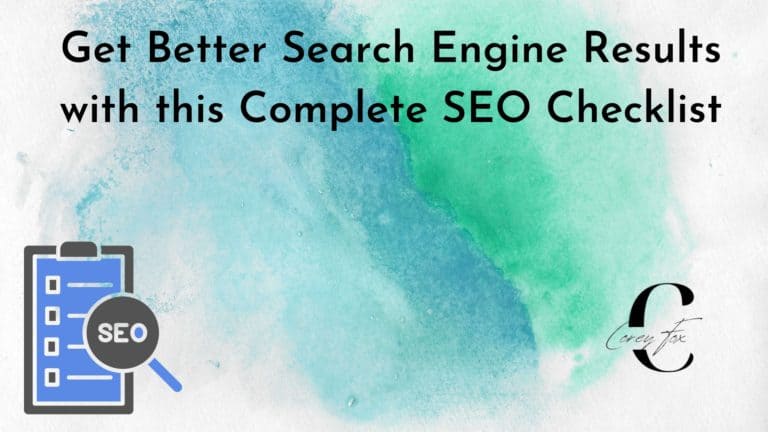How to Write SEO-Friendly Blog Posts with Maximum Impact
Last Updated on October 6, 2023 by Corey Fox
It’s no secret that SEO is important for driving organic traffic to your blog. But what’s often overlooked is that your content must be well-written and engaging. In this post, I’ll share some tips on how to write an SEO-friendly and well-optimized blog post that will capture your readers’ attention and keep them coming back for more.
A Summary of How Google Works When It Comes to SEO

Google is a tech giant, and its addition of SEO (Search Engine Optimization) has enabled it to become even more intelligent.
SEO ensures that you get the most optimal results based on your search queries when you search the web.
It works by organizing the web for improved page ranking and visibility, allowing for more relevant search results that are better organized and tailored toward a particular user.
Google assesses over 200 factors to determine which websites appear higher in rankings, so it’s important to ensure your website is optimized to land a top spot on the first page.
When developing a new website for SEO purposes, it’s important to know Google’s infamous “sandbox effect.”
This is essentially when Google withholds organic search traffic from newly created sites for an undetermined period of time.
It can be frustrating for webmasters who anticipate getting big rewards quickly.
Fortunately, there are steps you can take to work towards more favorable SERP rankings and get out of the sandbox sooner.
Focus on producing high-quality content (with writing tools such as Jasper.ai and Surfer SEO) that will attract natural links, optimize the content around your target keywords, and build relationships with bloggers willing to link back to your site.
Although there’s no magical formula or guarantees, following these best practices should help you escape the sandbox much quicker.
What is SEO Writing?

SEO Writing is the practice of creating content that is optimized to show up in the SERPS.
Writers can help their clients or employers get more visibility on search engines like Google, Bing, or Yahoo by optimizing content for certain keywords and phrases.
SEO blog writing also involves considering other factors, such as your blog structure and readability, to ensure users find it easier to consume the content.
To become an effective SEO Writer, one must understand how search engines work and what type of content appeals to them.
This means knowing algorithms and understanding user intent when searching for particular topics.
In addition to writing optimized content, SEO Writers are also responsible for optimizing other aspects of a web page, such as heading tags, meta descriptions, internal links, images, etc.
These tasks are important as they help improve the website’s visibility in SERPs (search engine result pages) and make it easier for customers to find what they want.
Benefits of Writing SEO-Friendly Blog Posts
SEO is the number one way to generate organic leads
As digital marketing rises, SEO is no longer just a nice-to-have. Instead, amplifying your reach and maximizing your profits has become necessary.
Search engine optimization is the number one way if you’re looking to generate organic leads and bring in high-quality customers who are already seeking out the services or products that you offer.
Investing in SEO is essential for your business to explode and be seen by customers who can give it the growth it needs.
A robust SEO strategy can mean the difference between anonymity and scaling up quickly.
Optimizing your website for search engine results will drive more conversion rates and increase the overall success of your business.
Having a website for your business is only the first step.
You must do more to ensure it works well and reaches your target audience.
Optimizing your website for search engine results is an effective way to get more eyes on your site, increasing your conversion rates and ultimately improving the success of your business.
This optimization process includes carefully selecting target keywords based on what you think people might search when looking for something related to your product or service, assuring that those keywords are sprinkled throughout your content, and constantly revisiting each page to ensure it remains relevant and up-to-date.
Investing effort into optimizing your website can result in considerable benefits.
Take the time to do it right and watch yourself reap the rewards.
SEO is a steadfast marketing plan that will yield long-term results
Think of it as an investment.
There may be an up-front cost, but SEO’s added visibility and traffic can yield rewards for years.
To avoid keyword stuffing, it’s about tailoring your content and copy to resonate with an audience and ensure your website remains competitive in today’s search engine climate.
Although other marketing methods certainly have their merits, no other offers the potential for organic growth that SEO does.
If you’re ready to set yourself up for success over months, if not years, investing in a strong SEO plan is the way to go.
SEO can help you enhance your visibility and reach more potential customers online
Search engine optimization is the key to unlocking your potential as an online business, helping you expand your reach exponentially.
By using several different strategies, including optimizing content for search engines, keyword research, and link-building, SEO can give your business the much-needed boost it needs to start succeeding in this digital age.
With SEO, you can ensure potential customers find you first when searching for products or services related to your industry.
SEO empowers you to focus on the most sought-after keywords and phrases, allowing your website to rank higher in search engine results
SEO is not only critical for website visibility, but it’s also an opportunity to improve the reach of your business online.
By researching the most sought-after keywords and phrases, you can craft a site that’s tailored to what people search for.
This helps put your website higher on search engine result pages. SEO-focused websites tend to have an extra edge regarding exposure and credibility.
Investing time in SEO can lead to increased traffic and higher click-through rates from search engines, making it well worth the effort.
SEO is a powerful tool that can facilitate the acquisition of backlinks to boost your website’s visibility and ranking
By using SEO to get backlinks, you can boost your online presence and drive up your site’s visibility in search engine results.
Backlinks from authoritative websites can significantly increase your website’s trustworthiness in search engine crawlers’ eyes and help you gain ranking faster than ever before.
Overall, using SEO to acquire backlinks is essential to mastering digital marketing and should not be ignored.
SEO is the perfect way to promote and market your business without having to resort to ads
It’s a great, cost-effective way to ensure potential customers can find your company! It can take a little work, but it will be worth it.
You’ll save money on expensive advertising campaigns while increasing your online presence.
After all, if you’re not visible online, customers may never find out about your business.
A successful SEO strategy can help get the ball rolling and bring more success to your company.
By optimizing your website for search engine rankings, not only will you gain credibility but also enhance your reputation
SEO can be a daunting task and time-consuming for many businesses.
If done correctly, though, the rewards are astounding.
Dedicating time and energy to ensuring your website is optimized for search engine rankings results in higher customer credibility and serves as an incredible endorsement of your business’s reputation.
This could be the factor that distinguishes you from other competitors when potential customers are comparing options.
Investing the time in optimizing your website can be well worth the effort if it helps take your business to the next level.
Unlock the Secrets to Crafting Effective SEO Optimized Blog Posts That Rank on Google with These SEO Tips
Start With Keyword Research

Carrying out keyword research before writing any content is essential for optimizing posts for search engine algorithms.
This will help you create content that potential readers can discover.
Here’s how you can do keyword research when writing blog posts:
- Analyze Relevant Search Queries – Using a keyword research tool such as SEMrush and Ahrefs, you can begin by analyzing relevant search queries related to your writing. Doing so will give you a good idea of what people seek regarding information and show which phrases they commonly use within said searches.
- Find Semantic Variations – While it’s important to include exact keywords within your post, it’s also beneficial to use semantic variations; understanding the context surrounding various key phrases can help make posts easier for everyone to understand. Using long-tail keywords (as opposed to single words) could also prove beneficial — especially if your post targets a more specific audience.
- Research Competitors – Looking at what other companies/bloggers have done in the past can often prove extremely helpful when crafting SEO-friendly content. Analyzing their copy not only allows you to look for ideas but also helps you figure out where there may be gaps in existing knowledge that your post could potentially fill.
By following these steps and carrying out keyword research beforehand, you can craft SEO-friendly blog posts that stand out.
Devise a Structure for Your SEO-Friendly Blog Posts

Creating an effective structure is essential when crafting content that appeals to people and search engine algorithms.
Here are some steps you can take to create a structure that works:
- Set the Tone – Introduce yourself and outline what readers can expect from your post; this will help ensure everyone is on the same page. Additionally, try to set the tone of your writing so that readers feel like they can engage with it — even if said content may be somewhat technical.
- Have a Clear Flow – Making sure any information within your post flows logically is essential; readers should understand how each section connects without confusion. To achieve this, consider using transitional phrases and signals to keep any text cohesive.
- Include Visuals – Adding visuals such as images and videos can often be an effective way of breaking up text — especially if you’re discussing topics that may not be exciting. Embedding relevant images or embedding clips are great ways of keeping potential readers engaged; ensure copyright laws are respected when doing so!
Cater Your Content to the People, Not Search Engine Algorithms When It Comes To Writing SEO-Friendly Blog Posts
When crafting content for blogs, it’s important to keep both people and search engine algorithms in mind — as both are equally important when generating results.
However, there should be more emphasis placed on writing content for humans first and foremost; after all, they are the ones who will ultimately be engaging with what you create.
Here are some tips on how you can cater your content to readers when creating SEO-friendly posts:
- Make Use of Natural Language – To ensure that your content is easy to understand, natural language should be used as much as possible. This may involve avoiding industry-specific jargon and using language that mimics everyday speech; this will help ensure everyone understands what is being discussed — regardless of their level of technical knowledge.
- Prioritize Engagement – Providing readers with a pleasant experience should always precede any attempts to optimize the post for search engine algorithms. Think about the type of content people would find interesting enough to read and delve into it further; doing so will give them something worthwhile while also helping increase engagement overall.
- Write For Clarity – To ensure that any text remains easy to read throughout its entirety, long paragraphs (as well as sentences) should be avoided as much as possible. Additionally, use headings/subheadings to break up information into smaller chunks, ensuring potential readers can quickly grasp key points without reading through pages upon pages of copy.
Create Captivating Blog Post Titles and URLs for Your SEO-Friendly Blog Posts That You Can Share With Your Audience
Crafting captivating blog titles and URLs is essential when it comes to driving traffic to your website — as well as improving search engine rankings.
Here are some steps you can take to achieve this:
- Be Descriptive – Make sure any titles you create accurately reflect the content users will find upon clicking on them. This may involve using keywords related to the discussion, which will help boost visibility in SERPs. Similarly, ensure the URL clearly states the topic so potential readers can easily discover your post.
- Keep It Short – Longer titles can be off-putting and may not fit into certain character limits (such as those found in social media posts); aim for a title length of around 60 characters or less when possible. Additionally, consider keeping URLs short if possible — many systems limit how much text can be used for link destinations, so truncating where applicable may be required.
- Be Creative – A good title should accurately describe content and be catchy enough to stand out from the rest of the content online. Incorporating fun metaphors and puns can often add that extra flavor, which helps you get people’s attention; however, make sure your content remains relevant.
Craft a Persuasive Call-to-Action (CTA) to Capture Attention and Inspire Readers to Take Action for Your SEO-Friendly Blog Posts

Call-to-actions (CTAs) can be powerful marketing tools, prompting readers to take action. To be successful, they need to stand out from the rest of the content and grab attention — requiring some creative thought.
Here are some tips on how you can craft an effective CTA that will capture readers’ attention:
- Be Clear – Make sure any instructions relating to your CTA are simple and straightforward so that readers know exactly what is expected of them. Avoid using too much jargon or long sentences that may confuse people; keep it concise and focused on one particular goal/desired outcome.
- Be Actionable – Use action words such as “get” or “start” to encourage people to click through or participate in whatever you offer directly. Additionally, use the imperative mood when writing this type of text to look more natural and persuasive — helping ensure readers will respond positively.
- Add Visuals – Eye-catching visuals such as buttons or images (if applicable) can draw attention to your CTA more quickly than plain text. Choose colors that match your brand identity while avoiding overly bright shades, which may hurt the overall user experience.
Optimize Your SEO-Friendly Blog Posts for Featured Snippets
Featured snippets are typically displayed at the top of SERP pages and can provide a great or even dominant presence, helping boost click-through rates.
Here are some practical steps you can take to achieve this:
- Answer Questions Directly – When creating blog posts, consider users’ questions about your topic and answer them directly in the post. Doing so will increase the chances of your content being chosen as a featured snippet since Google will likely pick up those answers if they meet its criteria.
- Include Keywords – As with most other types of SEO, including relevant keywords within the text is crucial for achieving good SERP rankings and featured snippets. Focus on incorporating search terms from the keyword research stage into body text, titles, headings, and meta descriptions; doing so will make sure your content is optimized correctly and stands out from competitors.
- Use Structured Data – While HTML tags such as
<h1>,<h2>and<p>should be used regardless of whether your content is intended for featured snippets; they become even more important when aiming for these particular positions. Ensure structured data is visible in the source code by adding Schema markup on certain elements (such as listing prices), which can help highlight them in searches — thereby increasing visibility.
Use Paragraphs and Headings for SEO-Friendly Blog Posts
When creating blog posts, it is important to include paragraphs that are well-structured and easy to read.
Doing so will make your articles more user-friendly and maximize the chances of people spending time on your website — potentially leading to more conversions or sales.
Additionally, headings can help optimize content for search engine ranking positions (SERPs).
Here are some tips on how you can achieve both:
- Break Up Text – To make blog posts easier to consume, break up text into shorter paragraphs with subheadings. Doing this will aid comprehension and make it simpler for people to find what they’re looking for quickly, improving their chances of staying longer on the page.
- Include Keywords – Where possible, incorporate relevant keywords into the body of text and headings — particularly those identified in the keyword research stage before writing the piece. Furthermore, aim for variations or synonyms of those words — not just one particular word/phrase — for search algorithms like Google’s to recognize multiple related terms within a single article.
- Use Structured Data – Finally, use HTML tags such as
<h1>or<h2>when formatting headings and<p>when separating different paragraphs from each other. Incorporating these elements will tell SERPs what content is being presented — thereby improving its chances of appearing higher on SERP rankings.
Boost Your Images to the Next Level by Adding Descriptive Alt Text

Adding descriptive alt text to images is an excellent way of making them more appealing and informative for viewers. Alt text can also help with SEO and assist people who use screen readers. Here are some tips on how you can create effective alt text:
- Describe the Image – The most important thing when writing alt text for an image is that it accurately describes its contents. Focus on conveying what the viewer would see if they had the ability — from color and shape to size or orientation — while still keeping things succinct and to the point.
- Focus On Clarity – Make sure that your alt text is easy to understand; even though it should be detailed, it should not be too wordy or difficult to comprehend at a glance. If possible, try using keywords related to your topic, as these will help boost search engine rankings and provide useful information about the image itself.
- Be Concise – When adding alt text, keep sentences brief and avoid unnecessary words such as “image” or “picture.” Also, don’t clutter your description with superfluous details — instead, strive for clarity above all else so viewers can quickly understand what the photo or graphic shows without further explanation.
By writing effective alt text for images, you can make them more appealing and engaging for viewers, which may result in higher click-through rates, boosting their visibility and improving overall traffic!
Incorporate Related Keywords to Improve SEO and Increase Visibility
Optimizing the content for search engines is necessary to make your website more visible on search engine results pages (SERPs) and improve its ranking. Here are some tips on how you can do this:
- Research Relevant Keywords – Before beginning, take some time to research what related keywords are being used in connection with similar websites or topics. This will help you determine which words and phrases people are looking for when searching for something related to your topic — guiding you as to which ones should be included in your content.
- Strategically Place Keywords Throughout Content – Once you have identified the relevant keywords, begin integrating them into your written pieces at appropriate intervals. Make sure that these words appear naturally within the text so they don’t seem out of place — doing so will also prevent algorithms like Google’s from punishing you for keyword stuffing!
- Use Synonyms & Variations – Don’t rely solely on one word; use synonyms or variations throughout the piece. For example, if a keyword is “dog,” then you could also use “puppy” or “canine” instead so that multiple related terms are taken into account by SERPs while still staying true to the meaning of the original phrase.
Maximize the Potential of Your SEO-Friendly Blog Posts by Optimizing Their Length for Optimum Effectiveness

To make your blog posts as effective and engaging as possible, optimize their length for maximum impact.
Here are some tips for doing so:
- Think About User Attention Spans – Regarding blog posts, readers tend to have short attention spans. Ensure that your post is concise, easy to read, and informative while providing enough detail on the subject matter — this will help keep visitors engaged throughout the entire piece!
- Define Keywords Outlines – Before starting to write, it helps if you already have an outline of key points or keywords that you want to cover to stay focused and organized during the writing process. This will also help ensure that all content is relevant and there isn’t too much “fluff” taking up space.
- Break Up Text With Visuals – Visuals such as images, charts, or diagrams can be a great way to break up text into smaller chunks so readers can easily digest information without getting overwhelmed. Additionally, visuals can provide more context, which may be difficult to explain using only words.
- Avoid Unnecessary Details – Though content needs to provide details about the topic, be wary of rambling on too much about irrelevant matters that don’t contribute to anything useful or interesting. Strive for brevity and cut out unnecessary words or phrases to ensure that each blog post reaches its optimal length (based on what feels right).
Link Your Existing Content to Create SEO-Friendly Blog Posts
Creating content for your blog is an important part of establishing yourself as an expert in your niche and growing a loyal readership. To be successful, however, you must also ensure that your pieces are optimized for search engine visibility.
One key aspect of optimizing blog posts is ensuring they link to other relevant pieces within the website.
Here are some tips on how to link to your existing content when it comes to writing SEO-friendly blog posts:
- Identify Related Posts – Before starting, take some time to look over other pieces of content you have created on similar topics or themes; this should give you ideas on what can be linked together. You may even want to create a “master spreadsheet” with all the posts (and their corresponding URLs) to access them easily when necessary.
- Include Links Within Your Content – As you write, consider where adding internal links can help direct readers from one post to another seamlessly if they are interested in learning more about the same subject matter. For example, if you have written a piece about a particular topic before and wish to include more information in your current post, linking back to the earlier post will provide helpful context and make sure visitors don’t miss out!
- Optimize Anchor Text – When selecting anchor text (the clickable words that lead readers from one spot in a post or page to another), try using keywords or phrases related to the source material and the linked page. Doing so will give additional clues about what each page contains without making them too long or distracting — helping engines like Google better understand how everything fits together.
Consistently Creating Fresh Content to Keep Your Readers Engaged and Informed
Creating great content is essential to running a successful online business, as it helps you build relationships with your readers, establish yourself as an expert in your field, and optimize for search engine visibility.
However, creating content is only half the battle — it’s also important to make sure that you are consistently creating fresh content to keep your readers engaged and informed.
Here are some tips for doing so:
- Define a Schedule or Frequency – Develop a plan on how often you want to post new blog posts or updates to ensure consistency. You can stick to a rigid schedule (e.g., Monday/Wednesday/Friday) or be more flexible depending on other commitments and resources (e.g., two articles per month).
- Set Aside Time for Research – Doing research should be part of every content-creating session. Before starting to write, set aside time to look up news stories, search through social media trends, and read relevant materials that can provide inspiration or ideas for topics to write about. This will help ensure your content is always fresh and engaging throughout the year.
- Mix Up Your Content Types & Topics – To avoid monotony, try mixing up different posts, such as tutorials, opinion pieces, interviews, etc., and topics related to your writing field. Keeping things varied will help keep readers interested while providing extra insights into various aspects of a subject matter.
- Engage With Other Writers and influencers – Learning from others with experience in the same subject area can help give new perspectives on existing ideas, leading to more exciting blog post angles and topics worth exploring. Networking with influencers in related fields can even provide unexpected collaborations between writers, ultimately resulting in totally unique pieces of content.
Including Keywords in Your Meta Description

Writing blog articles is a great way to reach more people and increase your visibility online.
However, it’s not enough to write good content — you must also ensure your post is optimized for search engine visibility.
One important component of optimizing posts for search engines is including keywords in the meta description.
Here are some tips for making sure you include keywords in your meta description when writing blog articles:
- Understand Search Engine Optimization (SEO) – Before diving into keyword inclusion, familiarize yourself with SEO basics. Knowing how things like keywords, meta descriptions, and titles work together will help you craft an effective strategy using them altogether.
- Research Relevant Keywords – Start by researching relevant keywords that could be used in combination with the topic of your article. Make sure they match the idea/topic you’re writing about and that they’ll be useful to online viewers by looking at data such as monthly search volume and competition levels.
- Incorporate Keywords Into Your Title & Article Body. Once you have identified appropriate keywords, incorporate them naturally into both the title of your post and the body of the article itself where relevant. This will give search engines clues as to what your piece is about each time someone searches related topics online, increasing the chances of ranking higher on SERPs (Search Engine Results Pages).
- Create an Engaging Meta Description That Includes Keywords. Finally, once everything else is ready, create an engaging meta description for your page that includes one or two of the most important/relevant keywords within it. This will help draw searchers’ attention while letting search engine crawlers know what queries this particular article should show up under when someone makes a query related to those terms online. You can use an SEO plugin like Yoast SEO or Rank Math to optimize your meta descriptions and blog titles.
By following these steps and properly including relevant keywords in your meta description when writing blog articles, you can help boost the visibility of each piece and ensure that more people find their way to your content.
Regularly Review Metrics for SEO-Friendly Blog Posts

Writing SEO-friendly blog posts is a great way to gain visibility and draw more traffic to your website, but it’s not enough to write and publish the post. To get the most out of your effort, you should regularly review your metrics to see what works and what doesn’t. Here are some tips for reviewing metrics when writing SEO-friendly blog posts:
- Analyze Traffic Sources – Look at data such as referral rates from search engines, links from other websites, or social media shares. Knowing where people come from can inform decision-making on which keywords or topics might better suit each blog post.
- Track Rankings & Impressions – Monitor how well your content ranks on the SERPs (Search Engine Results Page) and how many impressions it gains relative to other pieces of content. This can help determine which content will attract more organic visitors and, thus, better SEO results overall.
- Look at How Your Content Gets Shared – Track how often readers share your content on social media and how much traction they get regarding likes/shares/retweets etc. Evaluating this data can help you refine strategies for future blog posts.
- Determine Real Visitor Value – Looking beyond just clicks and page views, track key performance indicators such as desired action taken by visitors (clicking a link or button), time spent on site, subscribers gained from particular posts, etc., to gauge the real value of different types of visitors that come via search engine queries generated by particular pieces of content.
By monitoring these metrics regularly, you’ll understand what strategies are working when creating SEO-friendly blog posts and which ones aren’t, enabling further refinement of your efforts going forward.
Construct a solid link-building plan that is sure to elevate your website’s visibility and search engine rankings
Getting more visibility for your website and improving its search engine rankings can be difficult, but it doesn’t have to be. Link-building is an effective step to help elevate your website and increase traffic.
To get the most out of link-building, it’s important to construct a good plan first.
Here are some key tips for constructing a solid link-building plan:
- Identify Your Objectives – Before beginning any link-building undertaking, you should identify what you want to accomplish with this effort. Is your goal higher search engine rankings? Increased visibility? A larger audience? Understanding what you want from your link-building efforts will help guide the process.
- Analyze Your Current Situation – Take stock of where you and your website currently stand regarding SEO and web presence. Analyzing existing backlinks, keyword usage, site structure, and other data points will help inform how you tackle building links.
- Research Keywords and Content Ideas – Once you understand what results you’re looking for from your link-building endeavors, it’s time to begin researching potential keywords, ideas for content that could attract links through organic searches or social media shares, etc.
- Identify Opportunities for Gaining Links – As part of researching ideas for content that could earn links, look into opportunities like blog carnivals, guest posts on other blogs, etc., or look into influencers in your industry who may be willing to share content created by you.
- Create Quality Content & Monitor Results – The final phase is creating compelling content and launching/monitoring it to see whether it earns traction (views/shares/etc.). Keep track of analytics data such as clicks from other websites onto yours when assessing the success or failure of particular pieces of content or strategies overall.
SEO Checklist to Optimize Your Blog Content
Here is an SEO checklist to help you optimize your blog content:
- Use a meta title tag to capture the keyword and add value as search engines display this in their results pages.
- Add an optimized meta description tag with a call-to-action that captures the user’s attention.
- Include relevant and targeted keywords in the blog post URL, ensuring it’s easy to read and not overly long.
- Utilize headings and subheadings (H1, H2, etc.) throughout the post, including targeted keywords where appropriate.
- Ensure images are optimized for the web by adequately naming them with relevant keywords and adding alt tags for better visibility on Google search image pages.
- Reference other high-quality sources within your article – if you can link these resources, even better.
- Add internal links when writing a new blog post, but only when it makes sense.
- Include external links from quality sites relevant to your post topic when possible – make sure they open in a new window or tab so visitors don’t leave your page immediately after clicking on them!
Conclusion
So there you have it!
Here are some simple tips to help you write an SEO-friendly, SEO-optimized blog post that will engage your readers and keep them coming back for more.
Just remember to focus on creating quality content that is informative and interesting, and be sure to use the right keywords throughout your post so that search engines can easily find and index your content.
With a little effort, you’ll be well on your way to driving organic traffic and making a lasting impression on your target audience.







